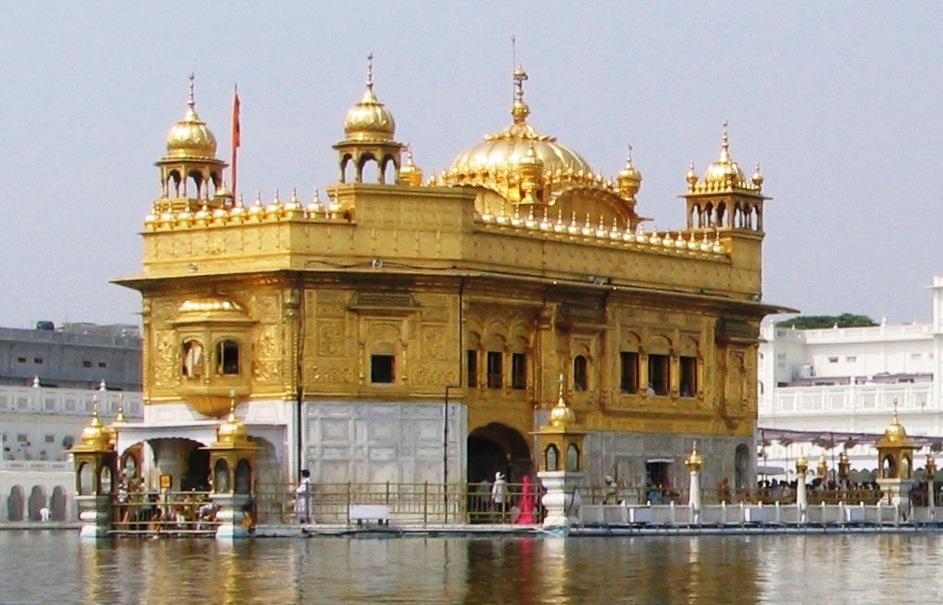

The Harmandir Sahib is considered the holiest shrine by Sikhs. The 11th and eternal Guru Sri Guru Granth Sahib Ji is present inside it. It is moved to the Sri Akal Takhat Sahib at around 10 PM and then moved back from there to Sri Harmandir Sahib at 4.45 AM,[3] site contains the time schedule, please note that there might be changes in the timing as per the season. Its construction was mainly intended as a place of worship for men and women from all walks of life and all religions to come and worship God equally.[1][4] The Sri Guru Granth Sahib is the holiest literature in the Sikh religion,[4] the tenth Guru of Sikhs, Sri Guru Gobind Singh on 7 October 1708 made it the eternal Sikh Guru and the leader of Sikhism.[4] Anywhere in the world where the Guru Granth Sahib is present is equally holy and precious to Sikhs. Harmandir Sahib was built with four doors to show that every religion or faith is allowed to go in to meditate or just listen to the prayers for peace.[5]
History
The fourth Guru of Sikhism, Guru Ram Das, excavated a tank in 1577 which subsequently became known as Amritsar (meaning: Pool of the Nectar of Immortality),[2] giving its name to the city that grew around it. In due course, a splendid Sikh edifice, the Harmandir Sahib (Temple of God),[2] was constructed in the middle of this tank which became the supreme centre of Sikhism. Its sanctum came to house the Adi Granth comprising compositions, Sikh values, philosophies and teachings of the Sikh Gurus and other saints of Guru Nanak’s time, e.g. Ravidas a Hindu Guru, Baba Farid a Sufi Sant (Saint) and Kabir, all of whom the Sikhs refer to as the Bhagats.
The compilation of the Adi Granth was started by the fifth Guru of the Sikhs, Guru Arjan Dev.
The Amritsar area
Amritsar is located in the Majha region of the Punjab. Majha is also known as the Bari Doab, since it is the Doab (Do = two, ab = rivers) or the (fluvial) tract of land which lies between two of the five great rivers of the province, the Ravi and the Beas. As such, Majha lies in the heart of the ancient Punjab region, comprising Gurdaspur, Batala and Tarn Taran Sahib as well as Amritsar. Amritsar is also known as “Sifti Da Ghar” or Adorable Abode.
The temple is surrounded by a large Sarovar (manmade lake), known as the AmritSar (Lake of Holy Water or Immortal Nectar). There are entrances to the temple on all four sides, signifying the importance of acceptance and openness; ostensibly, complex t. There are threeholy trees (Bers) each associated with a historical event or Sikh saint. Inside the temple there are many memorial plaques that commemorate past Sikh historical events, saints, martyrs and includes commemorative inscriptions of all the Sikh soldiers who died fighting in the two World Wars. For a new visitor the first recommended place to visit is the information Office and followed by visiting the Sikh Central museum near the main entrance called the Ghanta Ghar Deori (clock tower gate). Anyone who wants to enter the Harmandir Sahib may do so, irrespective of religion, colour, creed or sex. The only restrictions are that the person must not drink alcohol, eat meat or smoke cigarettes or use other non prescription drugs while in the shrine. Visitors are, as well, expected to dress appropriately and everyone must cover their heads as a sign of respect, remove their shoes and socks and enter the temple barefooted. Visitors must wash their feet in the small pool of water as they enter the Harmandir Sahib premises. Head scarves are provided.